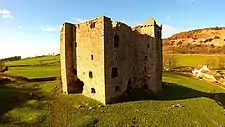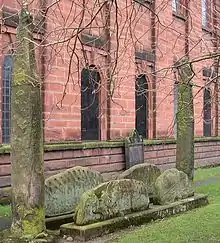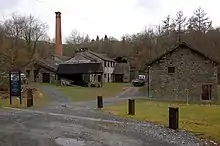Scheduled monuments in Cumbria
There are 1274 scheduled monuments in the county of Cumbria, in North West England.[1] These protected sites date from the Neolithic period and include barrows, stone circles, Roman forts, standing stones, 19th century industrial sites, abbeys, and ruined castles.[2] In the United Kingdom, the scheduling of monuments was first initiated to insure the preservation of "nationally important" archaeological sites or historic buildings. The protection given to scheduled monuments is given under the Ancient Monuments and Archaeological Areas Act 1979[3]
Notable scheduled monuments in Cumbria
| Image | Name | Location | Date | Notes |
|---|---|---|---|---|
 |
Ambleside Roman Fort | 54.4223°N 2.9688°W | 1st century AD | The fort was first occupied around 90 AD with the construction of a timber and turf fort. A larger stone fort replaced the timber fort during the reign of Hadrian (117-138 AD) and was probably abandoned 138–161 AD.[4] |
.jpg.webp) |
Appleby Castle | 54.57423°N 2.48878°W | Early 12th century | A well-preserved medieval castle with a large quantity of surviving earthwork defenses and standing structures.[5] |
 |
Arnside Tower | 54.1841°N 2.8335°W | 15th century | A late medieval tower house. Tower houses were common in the border regions of northern England and southern Scotland. Arnside tower is an excellent example of a Cumbrian peel tower. .[6][7] |
 |
Birdoswald Roman Fort & Hadrian's Wall | 54.9894°N 2.6023°W | early 2nd century AD | The Birdoswald Roman fort and a section of Hadrian's Wall and vallum between the River Irthing and the field boundaries east of milecastle 50.[8] |
 |
Brough Castle | 54.5218°N 2.3244°W | 1092 | The monument includes Brough Castle and Brough Roman fort. The surviving castle remains are an excellent example of six centuries of continuous improvements. Substantial earthworks of the Roman fort is partially covered by the castle.[9] |
.jpg.webp) |
Brougham Castle | 54°39′14″N 2°43′09″W | early 13th century | The castle's surviving remains include a great keep, a rare double gatehouse and a commanding southwest corner tower, known as the 'Tower of League'.[10] |
 |
Calder Abbey | 54°26′39″N 3°27′58″W | 1134 | Twelve monks from Furness Abbey, Barrow-in-Furness, Cumbria, established the Savigniac abbey at Calder. The abbey became Cistercian in 1148.[11] |
 |
Carlisle Castle | 54.897260°N 2.941936°W | 1092 | The monument consists of the surviving remains of the castle's medieval tower keep castle, a section of Carlisle city wall, a 16th century battery, and the underground remains of much of the Roman fort known as Luguvalium.[12] |
 |
Castlerigg stone circle | 54°36′10″N 3°05′54″W | 3200 BC to 2500 BC | An oval enclosure of 38 standing stones which contains a smaller enclosure and two barrows, and an outlying stone.[13] |
 |
Dalton Castle, Cumbria | 54.1554°N 3.1865°W | 14th century | The monument includes both the above ground and below ground remains of Dalton Castle, which was previously used as the manorial courthouse of Furness Abbey. It was used as a prison from the early 13th century to the late 18th century.[14] |
 |
Furness Abbey | 54°8′7″N 3°11′52″W | 1123 | The abbey was established by Stephen, King of England. The surviving remains consist of most of the east end and west tower of the church, the chapter house and the cloister buildings.[15] |
 |
Giant's Grave St Andrew's Church | 54.66428°N 2.75107°W | 12th century | The monument includes two Anglian cross shafts and four hogback stones, located in St Andrew's churchyard, Penrith. It also includes a pair of tenth century Anglian crosses. [16] |
 |
Giant's Grave, Cumbria | 54.21833°N 3.32633°W | Neolithic era | Two Neolithic standing stones located in a field on the coastal plain of west Cumbria, near Kirksanton village.[17] |
 |
Lanercost Priory | 54.9662°N 2.6949°W | late 12th century | Founded by Augustinian cannons. What remains of the priory are the ruins of the chancel and transepts, and the 13th-century nave which was converted into a parish church.[18] |
 |
Long Meg and Her Daughters | 54.72794°N 2.66765°W | Neolithic or Bronze Age era | A stone circle, a linear earthwork lying west of the stone circle, and a Neolithic enclosure to the north.[19] |
 |
Ravenglass Roman Bath House | 54.3507°N 3.4042°W | 2nd century AD | A ruined ancient Roman bath house located northeast to the Roman fort.[20] |
 |
Stott Park Bobbin Mill | 54.2855°N 2.9659°W | 1835 | A very large working mill which has produced millions of wooden bobbins essential to the Lancashire weaving and spinning industry.[21] |
References
- "Scheduled monuments: Cumbria". Historic England. Retrieved 7 February 2023.
- "Scheduled Ancient Monuments in the Historic County of Dorset". Ancient Monuments UK. Retrieved 28 January 2023.
- "Scheduled Monuments". Historic England. Retrieved 28 January 2023.
- "Ambleside Roman Fort". Historic England. Retrieved 13 February 2023.
- "Appleby Castle, uninhabited portion". Historic England. Retrieved 13 February 2023.
- "Arnside Tower". Historic England. Retrieved 13 February 2023.
- "Arnside Tower". Visit Cumbria.com. Retrieved 13 February 2023.
- "Birdoswald Roman fort and the section of Hadrian's Wall and vallum between the River Irthing and the field boundaries east of milecastle 50 Listed on the National Heritage List for England". Historic England. Retrieved 14 February 2023.
- "Brough Castle and Brough (Verteris) Roman fort and civil settlement". Historic England. Retrieved 14 February 2023.
- "Brougham Castle". English Heritage. Retrieved 14 February 2023.
- "Calder Abbey". Historic England. Retrieved 14 February 2023.
- "Carlisle Castle; medieval tower keep castle, two lengths of city wall, a 16th century battery, and part of an earlier Roman fort known as Luguvalium". Historic England. Retrieved 14 February 2023.
- "Castlerigg stone circle and two bowl barrows". Historic England. Retrieved 14 February 2023.
- "Dalton Castle". Historic England. Retrieved 14 February 2023.
- "Furness Abbey". English Heritage. Retrieved 14 February 2023.
- "The Giant's Grave - Two Anglian cross-shafts and four hogback stones in St Andrew's churchyard, Penrith". Historic England. Retrieved 15 February 2023.
- "Giant's Grave standing stones, Kirksanton". Historic England. Retrieved 14 February 2023.
- "Lanercost Priory". Britain Express. Retrieved 14 February 2023.
- "Long Meg and Her Daughters stone circle, associated cursus and prehistoric enclosure". Historic England. Retrieved 14 February 2023.
- "Ravenglass Roman fort". Historic England. Retrieved 14 February 2023.
- "Stott Park Bobbin Mill". English Heritage. Retrieved 15 February 2023.
This article is issued from Wikipedia. The text is licensed under Creative Commons - Attribution - Sharealike. Additional terms may apply for the media files.